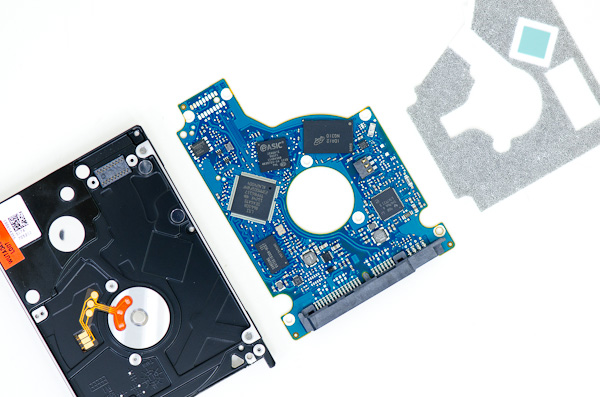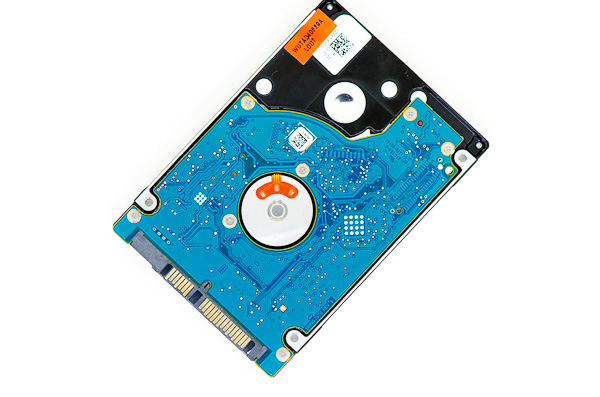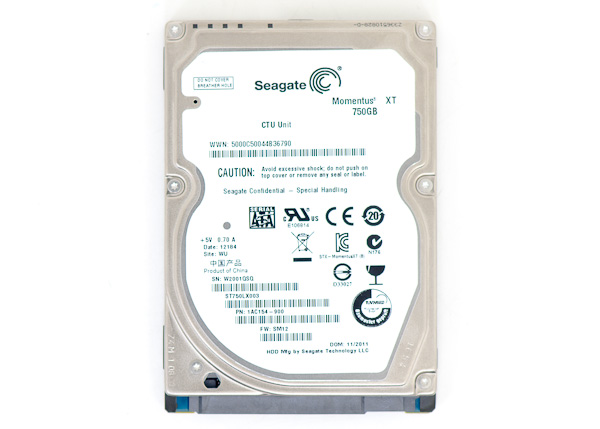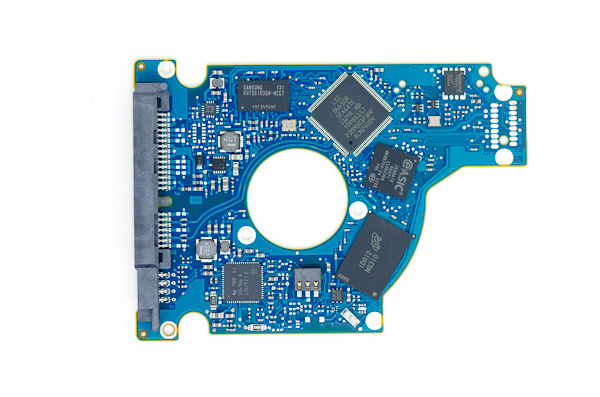Seagate 2nd Generation Momentus XT (750GB) Hybrid HDD Review
by Anand Lal Shimpi on December 13, 2011 12:51 AM EST- Posted in
- Storage
- Seagate
- Momentus XT
- Hybrid Drive
- HDDs
- SSHDs
To say I liked the original Momentus XT would be an understatement. While Seagate had the lofty goal of negating the need for an SSD with its first mass-market hybrid HDD, the reality was the Momentus XT ended up being the best 2.5" hard drive on the market. In many cases, it was fast enough to be better than 3.5" desktop hard drives as well.
Seagate earned this praise by combining a small amount of of SLC NAND (4GB at the time) with a traditional 7200RPM 2.5" hard drive. A separate NAND controller was introduced to handle caching of frequently accessed data to the NAND. By acting solely as a read cache (only read requests to the drive are pulled into the cache), Seagate skirted the complicated issue of effectively building an on-board SSD by only caching reads from the hard drive and not writes to it.
It's Analogy Time: How Caches Work
Caches are pretty simple to understand. Let's say you're running a library with thousands of books and thousands of users. Allowing everyone to roam freely would create a traffic nightmare so you make all requests for books go through your help desk. A customer approaches the desk, tells your employee what book they want, and your employee runs to grab the book. This happens for each request. The time it takes your employee to return with a book after receiving a request from a customer is your service time and it's a value that you want to keep as low as possible in order to prevent you losing your customers to another library.
Over time your employee may notice that certain books are frequently requested. A smart employee would decide to have copies of these books at the help desk, to more quickly service those requests. With a large enough desk, your employee could likely accommodate a good percentage of the requests that come by. At the end of the day, doing so would lower your service time and allow you to serve more customers. Requesting a book not located at the help desk would still take the same amount of time.
If reading patterns change over time, your employee could adapt. Assuming there's a finite amount of space at the help desk, books that are no longer as frequently read as they once were could be evicted from the desk and replaced with more popular titles.
The library I've described above is an example of a cache. The books are of course data, the customers are instructions and the help desk is the cache itself. Data that's accessed more frequently is stored in the cache and as access patterns change, so does the data in the cache.
Improving Mechanical Storage via a NAND Cache
Caches exist in several locations in any modern day computer, both in hardware and software. We often talk about CPU caches that are used to save trips to main memory, but in the case of Seagate's Momentus XT there's an on-board NAND cache to save trips to the spinning platters.
The mechanical components of a hard drive are what make it slow. Dealing with electrons is far quicker than waiting to reposition a head over a spinning platter. For a while, hard drive manufacturers were able to improve performance through spinning the magnetic platters at higher speeds. Power and reliability concerns have limited progress in spindle speed however, most high performance client drives spin their platters at 7200RPM. Instead, increasing platter density has been the hard drive maker's weapon of choice to address performance over the past decade.
Improving platter density only really addresses sequential access performance, without faster spindle speeds, random access performance remains mostly untouched from one generation to the next. Amdahl's law tells us the maximum speedup we can hope to gain from a new system is ultimately bound by the portion of the system that isn't upgraded. The same rule applies to hard drives. For any workload that isn't perfectly sequential in nature, not addressing random access performance means that improvements to platter density will provide increasingly smaller performance improvements. In other words, even if you double sequential performance, you'll see a less than double increase in overall performance. Taken to the extreme, it'll eventually mean that doubling the sequential performace of a hard drive will result in virtually no impact in overall performance.
Granted the hard drive manufacturers won't let it get to that point, and the Momentus XT shows us one path to avoiding this problem.
Seagate takes its standard 7200RPM 2.5" drive architecture and combines it with a NAND controller, firmware and 8GB of SLC NAND. The job of the NAND controller is to look at LBAs requested by the host controller and pull the most frequently read data into the NAND. A copy of the data remains on the mechanical drive, so in the unlikely event of a failure in the NAND the data is still safe. The controller only caches read requests to the drive, which has a couple of major implications. On the one hand, this greatly simplifies the Momentus XT's architecture. It reduces traffic to the NAND, allowing for a simpler page management algorithm and guaranteeing longer lifespan (although using SLC NAND already helps in that department). On the other hand by only caching reads, it means that writes to the hard drive are no faster than they would be on a more conventional drive. Seagate is banking on the fact that most client usage models are read rather than write heavy. Although the Momentus XT's NAND doesn't directly cache writes, it can improve write performance by allowing the drive to service some reads through the cache, thus freeing up the drive's heads for write operations instead of being weighed down by servicing both.
The New Momentus XT
The Momentus XT originally only had 4GB of SLC NAND on board, but the second generation 750GB version now comes with 8GB. The new drive retails for $249, up nearly $100 from the $156 MSRP of the original 500GB version.
| Seagate Momentus XT Comparison | ||||
| ST750LX003 | ST95005620AS | |||
| Capacity | 750GB | 500GB | ||
| Sector Size | 4KB | 512B | ||
| DRAM Buffer Size | 32MB | 32MB | ||
| NAND Cache Size | 8GB SLC NAND | 4GB SLC NAND | ||
| SATA Interface | 6Gbps | 3Gbps | ||
| Price | $245 | $140 | ||
A doubling of the NAND capacity allows Seagate to be much more aggressive with caching. The Momentus XT will now achieve near peak-performance in many cases by the second time you access data, while its predecessor could require more runs to make optimal use of the cache.
Seagate will eventually use the larger NAND to cache writes as well as reads. Early next year 750GB Momentus XT owners will get a firmware update adding write caching support. I've played with an early version of this firmware and it does improve performance tremendously.
Intel obviously believed that 20GB was the right size for an SSD cache, so why did Seagate stick to 8GB when upgrading the Momentus XT? Ultimately it's an issue of cost. Seagate is hoping to drive its hybrid HDD technology into the mainstream by convincing OEMs to use its Momentus XT drives. To gain widespread adoption Seagate needs two things: 1) aggressive pricing and 2) a second supplier of hybrid HDDs.
Hard drives are treated as commodities by all OEMs. They're a checkbox on a spec sheet that typically only values capacity and cost. Performance can be used as an upgrade but only if the capacity and cost points are compelling. It's this mentality that limits the Momentus XT to 8GB of NAND while encouraging an upgrade to a 750GB capacity. From a performance standpoint, Seagate probably needs at least twice as much NAND on board to really deliver an optimal solution for all users. Ideally I'd like to see 32GB of NAND on a hybrid drive like the Momentus XT. Unfortunately, by using SLC NAND Seagate pretty much guarantees it's not going to ship anything close to that size anytime soon.
Meeting the second requirement is a more difficult one. Most OEMs want two suppliers for commodity parts like display panels or hard drives. Today, Seagate is the only HDD manufacturer delivering a high-performance hybrid solution like the Momentus XT. Seagate does expect this to change eventually, but until it does the Momentus XT's sales potential is limited.
With the second generation Momentus XT we have a hybrid hard drive that has the ability to outperform its predecessor, without really seeing the huge upgrade necessary to fully negate the need for an SSD. To quantify the performance improvement over the previous generation as well as its place in the HDD-SSD continuum, we turn to a mix of application based, trace based and synthetic benchmarks.














98 Comments
View All Comments
7Enigma - Thursday, December 15, 2011 - link
2 drives completely separate. Have your OS and frequently used programs/games on the SSD (this obviously can vary widely due to SSD size), and store the remaining media on the traditional HDD. This is how I and many people use it.I have a second gen 80GB Intel drive as my boot/programs/select game(s), and then everything else is on a separate drive.
mmaenpaa - Tuesday, December 13, 2011 - link
Hi,Just wanted to chip in. I have installed tens of these (meaning older revision Momentus XT) to our customer's PCs. Normally user's store stuff just where it goes and that place beings systemdrive. Using two different partitons even is usually too advanced for average user. Trust me, I have 20 years of experience from the days we installed 40MB drives into PC's.
Intel RST (SSD + MECH HDD) solves this nicely, but we have only put one of these out there. And of course one unfortunate power outage meant a trip to our office. As the user did not know how to recover from this (and frankly I had to use a bit of time also). Of course we had only the read caching version enabled but still not very (average)enduser friendly solution.
Momentus XT also fits very well on normal usage which is suprise suprise:
power on computer
wait for desktop
start outlook (corporate users)
start internet browser
start your erp (corporate users)
do some ligth editing with office
Read only works wonders with this setup.
Reliability has so far been excellent. I have about 40 pieces out there and I have possibly one flaky one (not verified yet). I have had problems installing to a few laptops old and new, then again I've had major problems with SSD (SFORCE2 & Intel 320). Most of them bios related, some sandforce related.
I have sold maybe 30 SSDs. One (Corsair NOVA series 64GB) broke totally (thanks to Ibas & 2500€ almost all data was recovered), one has been rma'd and two more are waiting for RMA process. So in my book I still like mechanical drives, they seldom brick themselves totally like this one SSD did.
Any way, I'll be putting mostly the older modelMomentus XTs into the machines. At this price point it is just too exepensive for corporate desktop (or home desktop). I'll wait for the write caching and a bit lower price point.
BR,
Markku
Denithor - Tuesday, December 13, 2011 - link
Install OS + programs on the SSD, remap Documents/Music/Video/etc into folders on the secondary HDD. That way if the SSD bricks it doesn't affect their "saved" files and there's no user data at risk.Of course, the secondary HDD isn't proof against failure, which is why I always recommend people back up regularly. They seldom do, but hey, then I can say 'I told you so.'
:)
Denithor - Tuesday, December 13, 2011 - link
Didn't they opt for 16+GB of MLC NAND and enable the random write firmware? With a good (even mediocre) controller writes shouldn't be a problem, the cost would be equivalent and they actually could give true SSDs a run for the money with the writes enabled. Combine this with a large capacity (1-2TB) platter drive and you'd have a winner!I'm guessing you guys (Anand) are under NDA for the write-enable firmware results?
AMv8(1day) - Wednesday, December 14, 2011 - link
Love the review, unfortunately I think the market landscape has changed enough with the cost of even the most expensive 120/8GB SATA 6Gbit/s SSD's falling below the cost of one of these, and the fact that you can pick up 2 2.5in 1TB external drives for the price of one of these, I only see a few scenarios where this drive could be beneficial.1) In a SFF box with 1 3.5 bay, RAID two together in a 2.5 to 3.5 adaptor to have one very fast 1.5 TB drive, provided the read/write caching scales well, that would effectively give most more than enough storage space without having to compromise with separate drive mapping or slower storage access. And it would provide the OS the 16GB of SLC NAND you feel it needs. Oh, and aprox. 380GBs more space than a 120GB/1TB SSD/HDD combo.
2) I would really like to see a comparison between this setup and all of the different software/hardware caching/Rapid storage technologies (Intel Rapid Storage Technology, LSI's CacheCade software & WarpDrive 2 Hybrid, OCZ's Synapse Cache SSD & RevoDrive Hybrid, and any other versions/implementations I'm missing.
Thoughts anyone? Anand? Thanks a lot for your articles, I've really enjoyed them.
navaneethg - Wednesday, December 14, 2011 - link
So, Processor -> Instruction cache -> L1 Cache -> L2 Cache -> RAM -> SSD "Cache" -> slow drive.That's a lot of cache to deal with. I guess in the library analogy above, the library will be filled with help desks within help desk within help desk .. :)
AMv8(1day) - Wednesday, December 14, 2011 - link
There's also RAMDisk in there!Denithor - Thursday, December 15, 2011 - link
You forgot the L3 Cache.:)
Shadowmaster625 - Wednesday, December 14, 2011 - link
There is no way and no reason a frickin $37 HDD and a $42 SSD should combine to cost $150 more than the sum of their parts. That's just a crock. Who the hell pays $250 for this trash when you can buy 200gigs of pure SSD for that much money? Highway robbery.bse8128 - Wednesday, December 14, 2011 - link
You briefly mention Intel RapidStorage, but unfortunately there's no benchmark of the regular Momentus with RST...